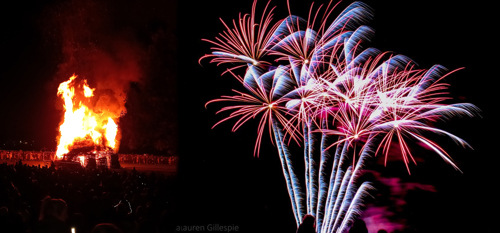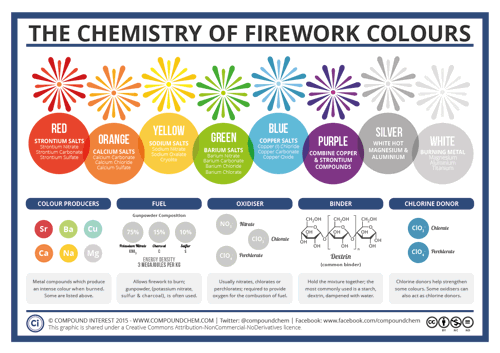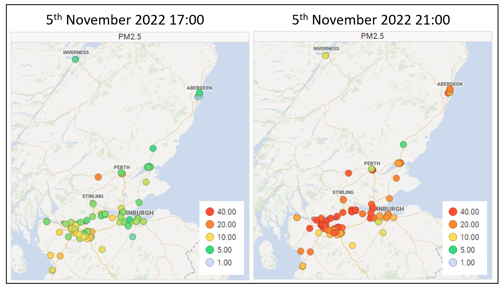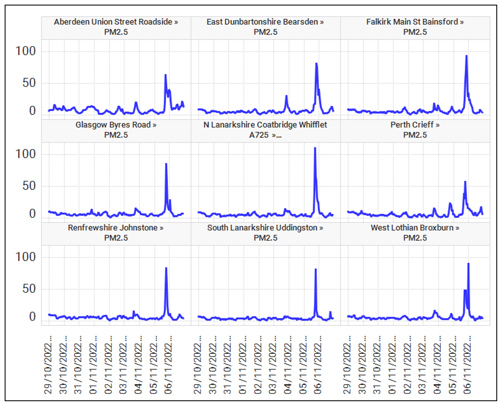Guy Fawkes night is very much a UK celebration, with the lighting of bonfires and setting off fireworks. Here we look at the consequences of these celebrations held on the 5th of November each year on air quality.
Colin Gillespie, Principal Scientist, SEPA
November 10, 2022
The Environmental Quality and Energy Functions from the Scottish Environment Protection Agency, tell us more.
Standing in a cold November night to enjoy Guy Fawkes celebrations we tend to forget about the environmental issues that are associated with the evening’s activities, such as air pollution. Guy Fawkes night can cause some of the highest air pollution episodes experienced across the UK.

Figure 1: Public bonfire & exploding fireworks Strathaven, 5th November 2022, Copyright © Lauren Gillespie.
Air Pollutants
Levels of air pollution rise as bonfires are lit and fireworks are set off. The plumes of dark smoke generated from bonfires contain high levels of soot, or black carbon. The exploding fireworks contain a mix of metal-based pollutants, including chemicals used to propel the fireworks into the air and to generate the bright colours (see Figure 2). The smoke left behind from the fireworks contain traces of metals, such as lead, titanium, and antimony (used to produce the crackles and sparkles), potassium and aluminium (added as propellants), and strontium, lithium, copper, and barium that give off the bright explosive colours of red, blue, green, and white The Chemistry of Fireworks – Compound Interest. The mix of smoke from bonfires and fireworks combine to form fine particles of pollution that are left suspended in the air. This is recorded as Particulate Matter (PM) and is linked to poor health effects. The pollutants can penetrate deep into the lungs, causing irritation of the airways, and breathing difficulties. This is particularly important to those with pre-existing health conditions, including asthma.

Figure 2: Colour chart illustrating the metals that provide the bright explosive colours in fireworks. Source: Archives – Compound Interest.
Weather plays its part
Guy Fawkes celebrations can cause widespread elevated levels of particulate pollution across the UK, depending on the weather conditions at the time. The weather can affect how long particles remain in the air and the direction they travel. If conditions are very calm the pollution may affect areas a long way from sources. Conversely, rain can help remove the pollutants from the air, depositing them on land. Weather conditions this year were relatively calm, with strong winds and early morning rain drying up to provide a perfect evening for watching local fireworks displays and lighting damp bonfires. In the evening there was a light westerly wind across much of Scotland, with rain expected from the west early on the 6th of November. Source: Met Office weather predictions for Guy Fawkes weekend 2022.

Figure 3: Met Office surface pressure charts showing pressure and weather fronts for the 5th and 6th of November for Europe and the North East Atlantic. Source: Reanalysis archives.
Air pollution levels across Scotland
SEPA’s live air quality tool captured the events across Scotland as they happened, with spikes of particulate pollution starting to appear from early evening. This can be seen by comparing concentrations of fine particulate matter (<2.5µm – PM2.5) between 1700 and 2100 (Figure 4). Concentrations of PM2.5 were raised across most of the network, with the dry and calm conditions allowing pollution levels to build up.

Figure 4: Changes in the status of air quality monitoring stations across Scotland between 17:00 and 21:00 on the 5th November. Source: SEPA Spotfire® visualisation tool – UK Air Quality.
The spike in particulates recorded across Scotland was relatively short-lived but very notable when compared to levels across the previous week. The graphs below (figure 5) show how concentrations of PM2.5 varied from the previous Saturday (29th October) until Sunday 6th November. There is some variation throughout the week which partly reflects day-to-day changes in the weather. However, the peaks in particulate concentrations are small when compared to Guy Fawkes night.

Figure 5: Changes in hourly PM2.5 concentrations (µg m-3) at nine Scottish sites between 29th October and 6th November 2022. Source: SEPA Spotfire® visualisation tool – UK Air Quality
How to reduce the environmental impacts of Guy Fawkes night
One way to reduce the environmental impact of Guy Fawkes night is to go to an organised public event. The total level of emissions from a public bonfire or firework display is lower than multiple smaller events or garden displays. Public event organisers also ensure that the correct material is being used in the bonfire, such as untreated wood. The organisers would also usually try to ensure that the bonfire is kept dry, thus reducing any additional emissions due to burning wet wood.
Some public events have started to include environmentally friendly fireworks (or eco-fireworks) within their displays. These fireworks use a clean burning, nitrogen-based fuel to reduce the amount of atmospheric pollution produced. This means less smoke is produced and therefore smaller amounts of metal salts are required to produce the same bright colour intensities, resulting in less harmful emissions containing metal elements.
There are also quieter fireworks which help reduce levels of noise pollution and are therefore better for animals. Some displays also opt for a mix of fireworks and laser or light shows. This provides the same bright visual effects but reduces the number of fireworks and associated emissions.
Adobe Acrobat Reader is the free, trusted leader for reliably viewing, annotating and signing PDFs.
Download Adobe Acrobat Reader





